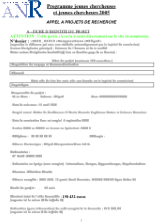Project submitted to the ANR
By Stephen Shimanek . Last update : 18 June 2007.
Résumé du projet
The project named "Leonard" on language acquisition and grammaticalization is rooted in the three CNRS laboratories to which the "young" researchers of our team belong. ICAR (Lyon) the main laboratory; SILEX (Lille) and LEAPLE (Paris) the two partners. This project has both a multidisciplinary and an international dimension. We wish to contribute to the expansion of research on language acquisition in France, to enhance the dialogue between linguists, psychologists, physicians, speech therapists, and to reinforce the position of French linguists on the international level. ((Our aim is to study the appearance and development of grammatical tools used by children between one and three years old)), which we will compare to the use of the same tools in adult speech, thanks to our collaboration with experienced researchers in our three laboratories. ((We will try to establish the order in which these markers appear and their link to the pragmatic context (requests, narratives, explanations...))). At this date, there is no database in France, shared by a community of scientists, that includes children’s data and particularly dialogues between children and adults in their natural environment. We are planning to collect, computerize and analyze several longitudinal follow-ups of children speaking French and French Sign Language. This data will be integrated in ICAR’s database named CLAPI but will also be formatted for the CHILDES database later on. We will use the verbal and non verbal context (intonation, mimics and gestures) in order to conduct qualitative analyses. ((The children’s verbal productions will be analyzed in relation to the adults’ role in the dialogue and their interpretation of their children’s utterances.)) Each corpus will be analyzed both by the researcher who will have collected the data and who will have built a relationship with the child and his or her family, and a researcher who doesn’t personally know the child. Our results concerning our data in French and in French Sign Language will be checked by using English, German and Italian data in CHILDES, thanks to the German, Italian and English speaking researchers in our team. Comparisons will be made with data of dysphasic children and data of children and adults learning a second language, collected by our team as well, both in France and in England. We want to establish various landmarks in the order of appearance and the use of grammatical tools, and share them with teachers, speech therapists, physicians who might need them in their work with children. But we also want to insist on the importance of respecting each child’s individual appropriation of language. This project, greatly inspired by the dynamism of psycholinguistics on the international level, will enable us to present the specificity of our approach as young French linguists thanks to oral communications in international conferences and recognized publications.


